Bryan Johnson, a tech millionaire and author, entered the limelight by sharing his Blueprint Protocol online, a science-backed routine designed to optimize his health and extend his lifespan.
Red light therapy (RLT), which Johnson has been using for years, is a crucial part of his daily routine. He uses RLT to reverse hair loss and graying, promote tissue regeneration, reduce skin damage, and support his overall health and longevity.
In this guide, we’ll explore Bryan Johnson’s red light therapy protocol, including the devices he uses. We’ll also explain whether red light therapy is worth your time and effort and examine an alternative DNA-focused approach that may be more accessible to the general public.
What is red light therapy, and why does Bryan Johnson use it?
Red light therapy (RLT), also known as photobiomodulation and low-level laser therapy (LLLT), is a treatment that uses low-wavelength red light and near-infrared light to target your skin and cells. It works by stimulating your cells to produce more energy, helping them repair damaged tissues and reduce the effects of aging.
Red light therapy is believed to be beneficial for several reasons, including:
Improved skin health
Reduced inflammation
Increased hair growth
Improved recovery
Reduced anxiety and depression
While his team of 30+ doctors recommended red light therapy as part of his daily routine, they are still measuring its effects and aren’t entirely sold on its direct benefits.
How does Bryan Johnson use red light therapy?
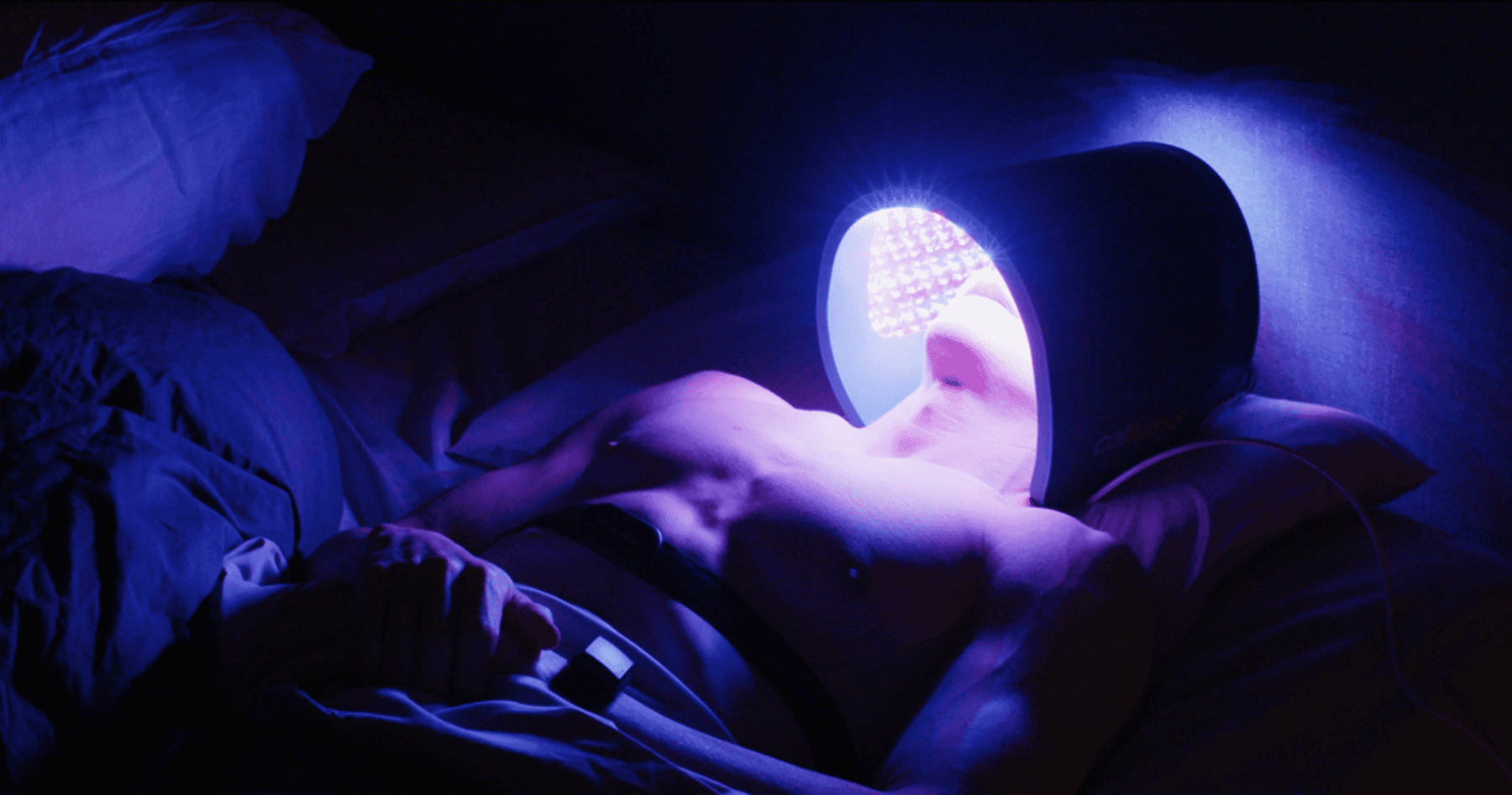
Source: Blueprint Protocol
Johnson uses red light therapy daily, employing several devices to target specific areas of his body.
Check out the protocol details in the following table:
The sections below will explain in detail how he uses each of these devices and what benefits he is seeing.
1. Capillus red light therapy cap
Bryan Johnson incorporates the Capillus red light therapy cap into his morning routine to promote hair growth and reduce graying. He wears the cap for six minutes after waking up as he continues his morning routine.
The cap contains 312 laser diodes that use low-level laser therapy to stimulate hair follicles, improving their health and regeneration. This treatment should increase blood flow to the scalp, providing more nutrients to the follicles and reducing thinning.
While Johnson has seen significant improvements in reversing hair loss, it’s hard to say whether this is due to red light therapy or other treatments he’s trying, including finasteride and minoxidil.
Note: Bryan Johnson does not explicitly recommend the Capillus cap and is currently looking for a better, more affordable replacement.
2. Celluma pro panel: Blue + red light therapy
Bryan Johnson uses the Celluma Pro panel for five minutes each morning as part of his anti-aging skincare routine.
The device combines blue and red light therapy and is placed over the face to improve skin health. Red light is thought to boost collagen production and promote skin healing, while blue light is believed to help reduce acne and blemishes.
Johnson has seen improvements in these areas but is still unsure whether Celluma Pro is worth the time, money, and effort. He uses it on and off because its benefits are hard to measure, especially compared to other treatments he uses, like Tixel and Intense Pulsed Light therapy, as well as his diet and regular supplements.
When he first launched Blueprint, his skin age was comparable to that of a 64-year-old. Now, it falls within the 37-42-year-old range. Still, it’s difficult to pinpoint how much of this improvement is due to red light therapy.
3. Full-body red light therapy panels
A setup consisting of two full-body red light and near-infrared light panels is a crucial part of Bryan Johnson’s red light therapy routine. He stands between the panels for 12 minutes three times a week.
Initially, he used a single panel, targeting his front and back. He later added another panel to treat both sides simultaneously, cutting his treatment time in half.
Here are the key specs of the panels he’s using:
Light type: Whole-body LED with 630 nm red and 830 nm infrared wavelengths
Modes: Continuous wave or pulsed up to 40 Hz
Irradiance: Up to 200 mW/cm² at a 6-inch distance
Energy dose: 60 J/cm² at a 6-inch distance
Johnson incorporates this therapy to improve skin health, support healing, boost mitochondrial function, help muscle and joint recovery, and even alleviate depression when applied to the forehead. His team believes the scientific evidence behind these benefits is strong, although the exact effects are hard to measure and quantify.
4. FlexBeam wearable RLT device
The FlexBeam wearable red light therapy device offers targeted treatment on specific body parts. Bryan Johnson recommends FlexBeam as an affordable way to use red light therapy across the body as needed.
He uses it to promote healing in areas that require extra attention. For example, after getting blood tests, he places the FlexBeam over the blood draw spot to help heal the vein. He also uses it to treat specific areas when he feels slight injuries from exercising or playing sports, such as on his knees, wrists, or shoulders.
Scientifically proven red light therapy benefits
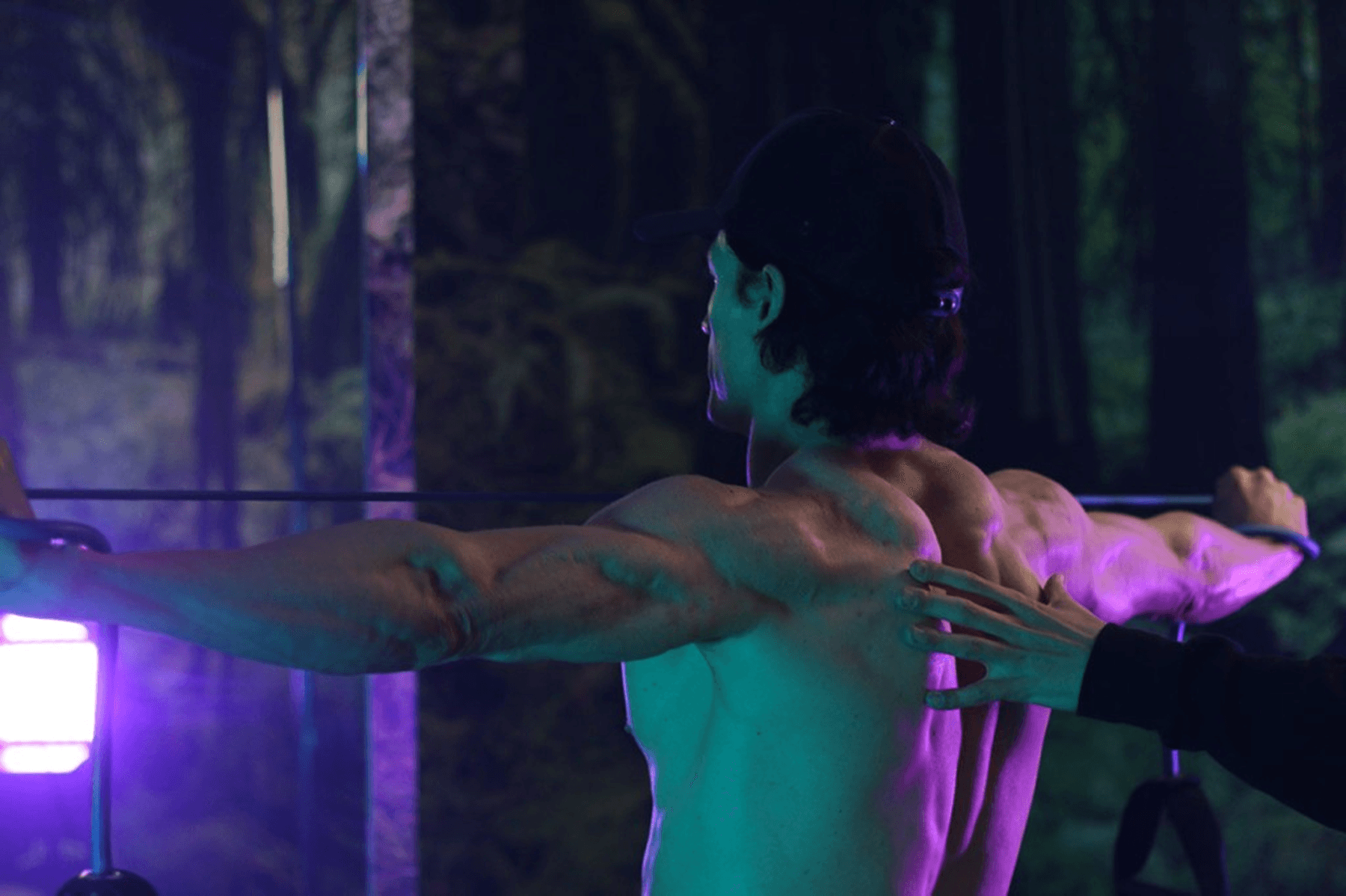
Source: Blueprint Protocol
Bryan Johnson’s red light therapy routine is based on a wide range of potential health benefits backed by science, including:
Improved skin health and anti-aging
Reversed hair loss and graying
Wound healing and tissue repair
Reduced pain and inflammation
Improved muscle recovery and performance
Reduced anxiety and depression symptoms
1. Improved skin health and anti-aging
Skin health is essential to Bryan Johnson’s Blueprint protocol, as he aims to not only reduce his age but also look youthful.
Red light therapy is important in achieving these goals because of its beneficial effects on skin health. Here are some key benefits indicated by recent studies:
Skin barrier recovery and inflammation: Red light (656 nm) was found to improve skin barrier recovery and reduce inflammation in human studies, enhancing skin resilience against damage.
Wrinkle reduction and skin rejuvenation: RLT increases collagen and elastin production, contributing to skin rejuvenation, wrinkle reduction, and improved skin elasticity.
Treatment of acne: A 2009 study has shown that red light is as effective as methyl-aminolevulinate for reducing acne severity without significant side effects.
Protection against UV damage: Research demonstrates that RLT protects skin cells against UV-induced damage by enhancing cellular repair and modulates genes involved in skin inflammation.
2. Reversed hair loss and graying
Bryan Johnson started losing hair in his twenties. He has a full head of hair today and believes that RLT has helped him achieve this. Recent studies seem to agree when it comes to:
Stimulation of hair growth: Low-level red light therapy at wavelengths around 650 nm seems to stimulate hair growth, especially in androgenic alopecia (male-pattern baldness).
Reduction in male and female hair loss: A 2021 systematic review has shown that LLLT effectively treats both male and female hair loss, increasing hair density and thickness.
Reversal of graying: RLT may slow down or reverse graying by reducing oxidative stress, a key contributor to hair graying.
3. Wound healing and tissue repair
Johnson uses the FlexBeam device for wound healing and tissue repair, especially after drawing blood or playing sports.
Studies have shown that red light therapy can accelerate wound healing and reduce pain, especially following burns and incisions.
RLT also seems to boost collagen production, which is important for skin regeneration and wound repair.
4. Improved muscle recovery and performance
Bryan Johnson works out one hour a day and regularly does trail running. He uses red light therapy for recovery, citing the following scientifically proven benefits:
Improved muscle performance and recovery: A 2015 systematic review found that RLT improves muscle performance by delaying fatigue and accelerating recovery, especially when used before exercise.
Reduction in muscle damage: Another study showed that photobiomodulation therapy may reduce muscle damage and fatigue after high-intensity training, but more research is needed to support these claims.
Increased ATP production: Research on mice showed that RLT increased adenosine triphosphate (ATP) production, improving muscle performance during intense exercise.
5. Reduced anxiety and depression symptoms
Bryan Johnson has mentioned in several videos that RLT may reduce anxiety and symptoms of depression when applied to the forehead. There is research to support these claims, but it is thin and inconclusive.
A 2012 study found that red light therapy may improve mood-related symptoms, such as anxiety, in older adults. Similar research on rats has shown that both red and near-infrared light may reduce depression and anxiety, with similar effects to some medicines, such as Citalopram.
Another study found that red light therapy affected parasympathetic activity in people with anxiety and depression, which helps regulate stress and induce calmness.
Does Bryan Johnson find red light therapy worth it?
Bryan Johnson’s red light therapy protocol remains important to his anti-aging routine, but he is not entirely sold on it. The effects of RLT can be hard to pinpoint and measure, which is why his team uses some of these devices intermittently. Johnson has seen huge improvements in skin and hair health but has repeatedly stated that it’s hard to determine RLT's impact on these results.
Before investing in expensive red light therapy equipment — which can cost thousands of dollars — you should consider spending your time and money on more concrete science.
Genome sequencing is a fantastic solution because it can provide detailed insights into your genetic makeup and explain how it influences various aspects of your health. Nucleus offers a whole-genome DNA health kit to help you understand the genetic factors that affect your skin and hair health, among other things.
By knowing what your body truly needs, you can take ownership of your health, make more informed decisions regarding your daily routine and diet, and spend your time and money wisely on procedures that will make a real difference.
Unlock personalized health insights with Nucleus DNA testing
Nucleus is a clinical-grade, physician-approved DNA testing platform that provides a complete analysis of your genetic makeup. It helps you understand the genetic and external factors that influence your health.
Unlike consumer tests like 23andMe, which analyze only a small part of your genome (less than 0.1%), Nucleus uses whole-genome sequencing (WGS) to examine your entire DNA.
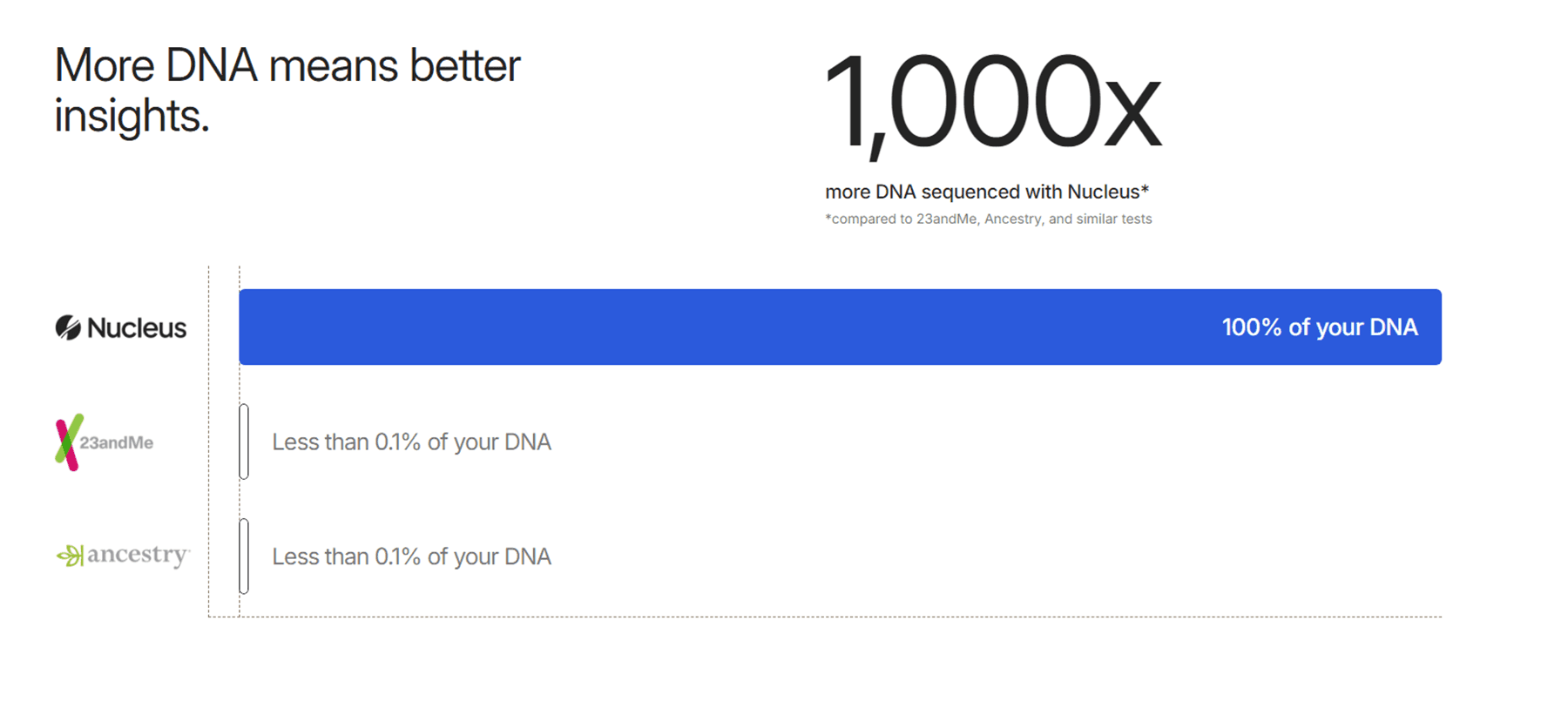
Nucleus also integrates genetic information with ancestry and lifestyle factors like age and BMI, delivering a personalized report that outlines the biggest risk factors for your health as well as your crucial traits.
Nucleus: Key features and value
Nucleus examines the risk of developing 170+ health conditions, including heart disease, cancer, and mental health issues like anxiety, depression, and ADHD. It also identifies rare and high-effect genetic variants that have a high probability of causing severe health problems, which most consumer-grade tests miss. Nucleus also offers trait reports, such as:
BMI
Height
Male-pattern baldness
Intelligence
Longevity
Severe acne
Seasonal allergies
Risk-taking
Muscle strength
What’s more, Nucleus Premium is not a one-time service — you’ll get continuous updates as new research emerges or your lifestyle changes. At only [PRICE.KIT_SOLO.ONE], it’s an affordable choice compared to standalone tests that can cost upwards of $3,000.
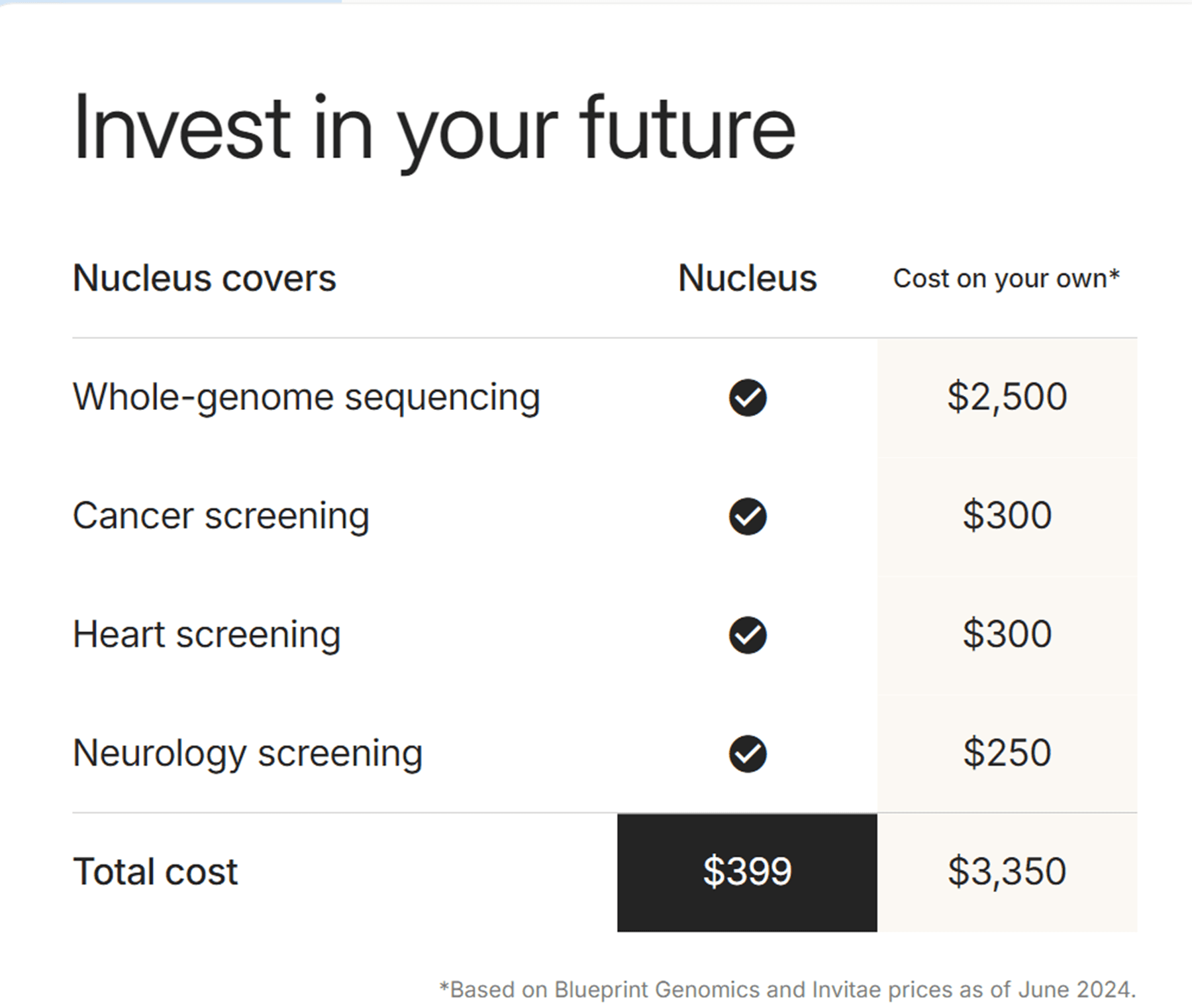
How to order your Nucleus DNA kit
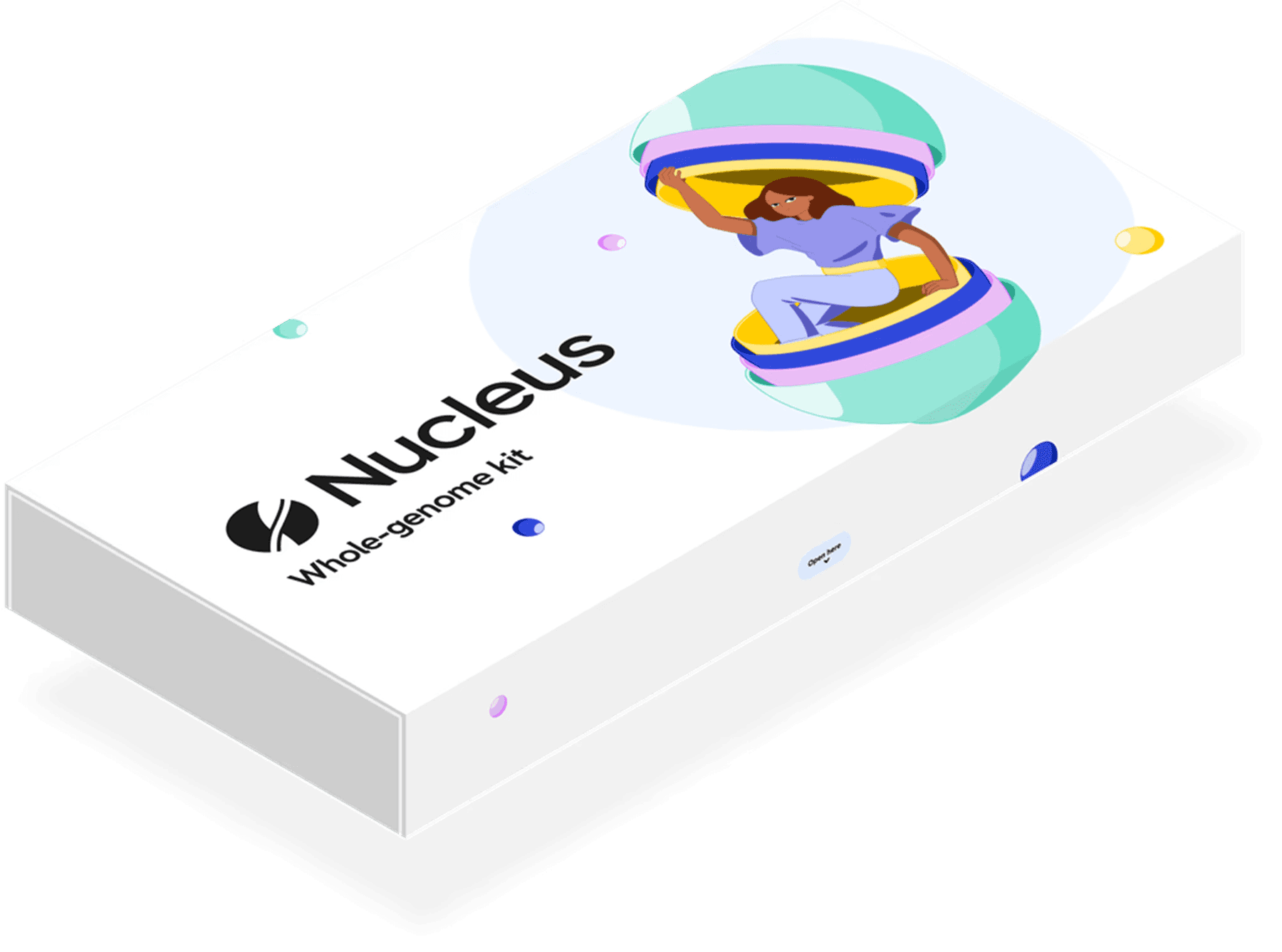
Here’s how to order your kit in a few simple steps:
Provide your personal information
Order the at-home DNA test kit
Once your DNA kit arrives, collect your samples by swabbing your cheeks as instructed and mail them back using the pre-labeled return envelope provided by Nucleus. Your results will be available on your Nucleus account within six to eight weeks.
Nucleus follows the standards of HIPAA, CAP, and CLIA. All tests are performed in the U.S. for added security.
Featured image source: Blueprint Protocol











